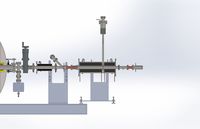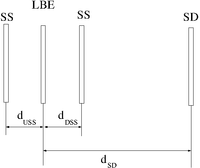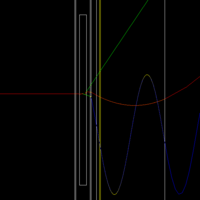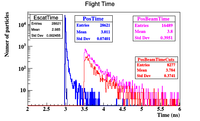Difference between revisions of "G4Beamline PbBi"
| Line 44: | Line 44: | ||
=== [[PbBi_BeamPipeHeating_w_Solenoid_2015]]=== | === [[PbBi_BeamPipeHeating_w_Solenoid_2015]]=== | ||
| − | ===Positron Collection rates with '''60 cm''' long Solenoid | + | ===[[PbBi_60cmLong_Solenoid_Collection_Efficiency_2015]]=== |
| + | |||
| + | Positron Collection rates with '''60 cm''' long Solenoid | ||
{| border="1" | {| border="1" | ||
Revision as of 16:45, 11 February 2016
Development of a Positron source using a PbBi converter and a Solenoid
Conclusions
- A 0.3 (0.6) Tesla Solenoid with a diameter to allow a 9.74 (3.94) cm diameter pipe would collect a positron per thousand incident electrons on a 2mm thick LBE target with 0.25 mm thick SS windows.
- A 15 cm long, 0.2 Tesla solenoid with a 3.94 diameter beam pipe would collect a positron per two thousand electrons impinging a 2mm thick LBE target with 0.25 mm thick SS windows.
- A 4 Tesla Solenoid will remove beam pipe heating from scattered electrons downstream of the target when using a 3.94 cm diameter beam pipe.
Reports
Task List
1.) Create a positron (10,000 positrons) and electron event file containing t,x,y,z,Px,Py,Pz for positrons exiting the solenoid and an incident Gaussian beam 1cm in diameter and with a sigma of 1cm.
compare distributions with and without solenoid.
2.) Determine the back ground when using a 3.48 diameter beam pipe and Solenoid field of 0.2 for a NaI detector placed at
3.) Experiment, install dipole and solenoid in the tunnel.
Beam Pipe Heating
Converter target properties
PbBi_NioWave_TargetProperties_2015
Target thickness optimization
PbBi_THickness_GaussBeam
PbBi_THickness_CylinderBeam
PbBi_THickness_PntSource
Solenoid
Uniform ideal Solenoid
PbBi_BeamPipeHeating_w_Solenoid_2015
PbBi_60cmLong_Solenoid_Collection_Efficiency_2015
Positron Collection rates with 60 cm long Solenoid
With SS windows
Positrons->Draw("sqrt(evt.BeamPosPosX*evt.BeamPosPosX+evt.BeamPosPosY*evt.BeamPosPosY)","evt.BeamPosMomZ>0 && evt.BeamPosPosZ>-500 && sqrt(evt.BeamPosPosX*evt.BeamPosPosX+evt.BeamPosPosY*evt.BeamPosPosY)<97.4/2");
| B-field (Tesla) | 34.8 mm diameter pipe | 47.5 | 60.2 | 72.9 | 97.4 | |
| 0.0 | 0.35 | 1,2,4,4,5 | 2,3,4,4,6 | 4,4,6,7,9 | 6,8,9,10,11 | 16,14,15,16,17 |
| 0.1 | 225,236,250,246,249=241 10 | 282,282,293,294,306=291 10 | 373,366,370,364,373=369 4 | 451,437,440,438,451=443 7 | 602,584,563,558,570=575 18 | |
| 0.3 | 0.35 | 626,619,596,619,611 =614 11 | 720,726,706,730,717=720 9 | 871,864,840,841,834 =850 16 | 987,968,939,943,952 =958 20 | 1118,1106,1069,1067,1080=1088 23 |
| 0.6 | 929,935,949,969,961=949 17 | 1022,1031,1046,1059,1052 =1042 15 | 1120,1130,1152,1154,1146 =1140 15 | 1168,1184,1210,1221,1206 =1198 21 | 1212, 1218,1240,1254,1242=1233 18 | |
| 1.0 | 0.35 | 1117,1085,1083,1061,1085=1086 20 | 1188,1154,1140,1111,1134=1145 28 | 1225,1190,1178,1149,1172 =1183 28 | 1243.1208,1195,1164,1184=1199 30 | 1252,1219,1206,1178,1200=1211 27 |
| 1.5 | 0.22 | |||||
| 2.0 | 0.10 | 1198,1210,1215,1223,1176=1204 18 | 1216,1227,1235,1241,1196 =1223 18 | 1237,1243,1252,1257,1214=1241 17 | 1249,1252,1262,1266,1225 =1251 16 | 1257,1262,1270,1276,1234=1260 16 |
| 4.0 | 0.002 |
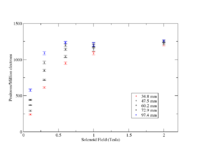
|
Positron & Electron event files
Event files were generated assuming an ideal solenoid having an inner radius of 2.527 cm surrounding a beam pipe with a radius of 1.74 cm. Electrons impinge a 2mm thick PbBi liquid target that has a surface area of 2.54 cm x 2.54 cm. Stainless steel windows 0.25 mm thick sandwhich the PbBi target at locations Z= -90.325 and Z= -89.875 cm. The target is located at Z =-90.1 cm and the beam begins 20 cm upstream at Z = -110.1 cm. The incident electron beam is a 0.5 cm radius cylinder.
Positrons exiting the Solenoid
The solenoid design has changed such that the max field is 0.20 Tesla (0.22) and its length is 150 mm.
In other words I should generate position and momentum files for positrons and electrons at the Z location 15 cm downstream from the middle of the LBE target and within a 3.48 cm diameter beam pipe.
/vis/viewer/zoom 2
/gps/pos/centre 0.0 0.0 -150.
/vis/viewer/panTo -90.1 0 cm
/vis/viewer/reset
Twenty (20) million incident electrons with an energy of 10 MeV and forming a cylindrical beam with a 0.5 cm radius cylinder impinged a 2mm thick LBE target located at Z = -106 mm. The Z location of positrons exiting the beam pipe at the end of the 15 cm long solenoid is 44 mm. The positrons are 150.00 mm from the middle of the LBE target (Z=44mm).
A space delimited text file with the above events in the format of
PID, x(mm),y,z,Px,Py,Pz(MeV),t(ns)
in units of cm for distance and MeV for momentum is located at
for positrons
http://www2.cose.isu.edu/~foretony/Positrons_2mm10MeVCyl.dat
and
http://www2.cose.isu.edu/~foretony/Electrons_2mm10MeVCyl.dat
The file below contains all the positrons that were created at the target
format
A space delimited text file with the above events in the format of
Initial electron (x,y,z,Px,Py,Pz), Final electron (t,x,y,z,Px,Py,Pz), Positron location after leaving LBE target (t,x,y,z,Px,Py,Pz),Location of positron as it exits a SS window (t,x,y,z,Px,Py,Pz). Units are ns, mm, MeV/c.
http://www2.cose.isu.edu/~foretony/AllPositrons_2mm10MeVCyl.dat
Positrons and Electrons after the SS Exit window
The same configuration as the previous subsection except that the 1mm thick sensitive detector is placed at Z = -100.5 mm. Most of the electrons exit at Z = -100.9 mm.
A space delimited text file with the above events in the format of
PID, x(mm),y,z,Px,Py,Pz(MeV),t(ns)
in units of cm for distance and MeV for momentum is located at
for positrons
23500 Positrons in the file below
http://www2.cose.isu.edu/~foretony/PositronsAtExitWindow.dat
and
297216 electrons in the file below
http://www2.cose.isu.edu/~foretony/ElectronsAtExitWindow.dat
Solenoid Map
Inner Radiusu=
Outer Radius =
Length =
Current=
Magnetic Field Map in cylindrical coordinates (Z & R) from Niowave
Rear Window Thickness
Question: Will a thicker downstream exit window increase the positron production efficiency by providing more material for a brehm photon to pair produce in?
Positrons were counted exiting a ideal 0.2 Tesla solenoid that was 15 cm long. A ten MeV electron beam with a 0.5 cm cylindrical radius impinged a 2mm thick PbBi liquid target that had a surface area of 2.54 cm x 2.54 cm. A 0.25 mm thick stainless steel entrance window was used.
Target is at -106 mm, entrance SS window is at -108.25 mm , exit SS window is at -103.75 mm, A sensitive detector for positron is placed at Z= +44mm. The sensitive detector is a cylinder of radius 11.74 cm.
| SS Exit WIndow Thickness (mm) | Positrons/Million electrons |
| 0.0 | 1142,1096,1149,1073,1083 = 1109 +/- 35 |
| 0.25 | 774,836,800,785,798 = 798 +/- 23 |
| 0.5 | 693,704,713,697,715 = 704 +/- 10 |
| 1.0 | 587,606,548,592,550 =577 +/- 26 |
- Conclusion 1
- Positron production efficiency improves when the exit window is made thinner
- Conclusion 2
- You loose about 28 +/- 4 % of the positrons in the 0.25 mm thick SS exit window.




